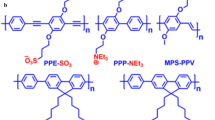Abstract
A series of poly(azomethine)s (PAMs) were synthesized from N1-(4-aminophenyl)-N1-(4-phenoxyphenyl)benzene-1,4-diamine (DA) and various dialdehydes to investigate the influence of structure of polymer chain and triphenylamine-based phenoxy pendant group on the optoelectronic properties. The structural characterization of the resulting poly(azomethine)s was carried out by solubility test, gel permeation chromatography, viscosity measurement, fourier transform infrared (FTIR) spectral and CHN elemental analysis. The photophysical and electrochemical properties of the materials were scrutinized by UV–vis, photoluminescence, time correlation photon counting spectral analysis (TCSP) and cyclic voltammetry. The thermal stability of the poly(azomethine)s was assessed by differential scanning calorimetry and thermogravimetric analysis found to be stable upto 300 °C. These polymers exhibit moderate inherent viscosity range from 0.99 to 1.15 g dL− 1 and appreciable organosolubility. The presence of triphenylamine and azomethine (CH = N) linkage in our synthesized materials rendered them fluorescent, emitting green light upon excitation at 375 nm with quantum efficiencies of 3.9–8.5%. The pendant phenoxy group at para-position in new poly(azomethine)s has also lowered the onset oxidation potentials and elevated the HOMO levels. Additionally, the presence of conjugation increases the fluorescence time of the excited state in conjugated polymers which was found in the range 9.22–11.17 ns, sufficient to be use in future optoelectronic applications.








Similar content being viewed by others
References
Liou GS et al (2007) Synthesis and characterization of wholly aromatic poly (azomethine) s containing donor–acceptor triphenylamine moieties. J Polym Sci Polym Chem 45(21):4921–4932
Barik S, Bishop S, Skene W (2011) Spectroelectrochemical and electrochemical investigation of a highly conjugated all-thiophene polyazomethine. Mater Chem Phys 129(1):529–533
Yen H-J and Liou G-S (2010) Novel blue and red electrochromic poly (azomethine ether) s based on electroactive triphenylamine moieties. Org Electron 11(2):299–310
Hindson JC et al (2010) All-aromatic liquid crystal triphenylamine-based poly (azomethine) s as hole transport materials for opto-electronic applications. J Mater Chem 20(5):937–944
Sek D et al (2008) Hole transport triphenylamine–azomethine conjugated system: synthesis and optical, photoluminescence, and electrochemical properties. Macromolecules 41(18):6653–6663
Sek D et al (2009) Characterization and optical properties of oligoazomethines with triphenylamine moieties exhibiting blue, blue-green and green light. Spectrochim Acta A Mol Biomol Spectrosc 72(1):1–10
Leclerc N, Pasareanu M-C, Attias A-J (2005) Synthesis and photophysical properties of polymers containing a novel class of light emitters. Macromolecules 38(5):1531–1534
Petrus ML et al (2015) Device performance of small-molecule azomethine-based bulk heterojunction solar cells. Chem Mater 27(8):2990–2997
Sánchez C et al (2014) Schiff base polymer based on triphenylamine moieties in the main chain. characterization and studies in solar cells. Thin Solid Films 562:495–500
Palewicz M et al (2011) Optical and structural study of thin film of polyazomethine with triphenylamine unit prepared via spin-coating method. Polymer Bull 66(1):65–76
Wang Y et al (2015) High coloration efficiency and fast switching speed of poly (amic acid-imide) s containing triphenylamine in acidic electrolyte. RSC Adv 5(15):11071–11076
Niu H et al (2004) Study on crystallization, thermal stability and hole transport properties of conjugated polyazomethine materials containing 4, 4′-bisamine-triphenylamine. Mater Chem Phys 86(1):33–37
Suh SC, Shim SC (2000) Synthesis and properties of a novel polyazomethine, the polymer with high photoconductivity and second-order optical nonlinearity. Synth Met 114(1):91–95
Weaver M, Bradley D (1996) Organic electroluminescence devices fabricated with chemical vapour deposited polyazomethine films. Synth Met 83(1):61–66
Yang C-J, Jenekhe SA (1995) Conjugated aromatic polyimines. 2. Synthesis, structure, and properties of new aromatic polyazomethines. Macromolecules 28(4):1180–1196
Irfan M, Belfield KD, Saeed A (2015) Carbazole/fluorene based conjugated small molecules: synthesis and comparative studies on the optical, thermal and electrochemical properties. RSC Adv 5(60):48760–48768
Aly KI, Khalaf AA (2000) New polymer syntheses. IX. Synthesis and properties of new conducting polyazomethine polymers containing main chain cycloalkanone and pyridine moieties. J Appl Polym Sci 77(6):1218–1229
Tsai F-C et al (2005) New thiophene-linked conjugated poly (azomethine) s: theoretical electronic structure, synthesis, and properties. Macromolecules 38(5):1958–1966
Iwan A et al (2014) New air-stable aromatic polyazomethines with triphenylamine or phenylenevinylene moieties towards photovoltaic application. Synth Met 195:341–349
Acknowledgements
Special thanks are due to both Prof. Dr Jaemin Lee and Dr Shahid ameen, Centre for Solar Energy Materials, Division of Advanced Materials, Korea Research Institute of Chemical Technology (KRICT) for providing guidance and cyclic voltammetry facilities for the completion of this work. Financial support of this project was provided by the Higher education Commission of Pakistan under Indigenous Scholarship Program (2PS-469).
Author information
Authors and Affiliations
Corresponding author
Rights and permissions
About this article
Cite this article
Khalid, N., Iqbal, A., Siddiqi, H.M. et al. Synthesis and Photophysical Study of New Green Fluorescent TPA Based Poly(azomethine)s. J Fluoresc 27, 2177–2186 (2017). https://doi.org/10.1007/s10895-017-2157-4
Received:
Accepted:
Published:
Issue Date:
DOI: https://doi.org/10.1007/s10895-017-2157-4




